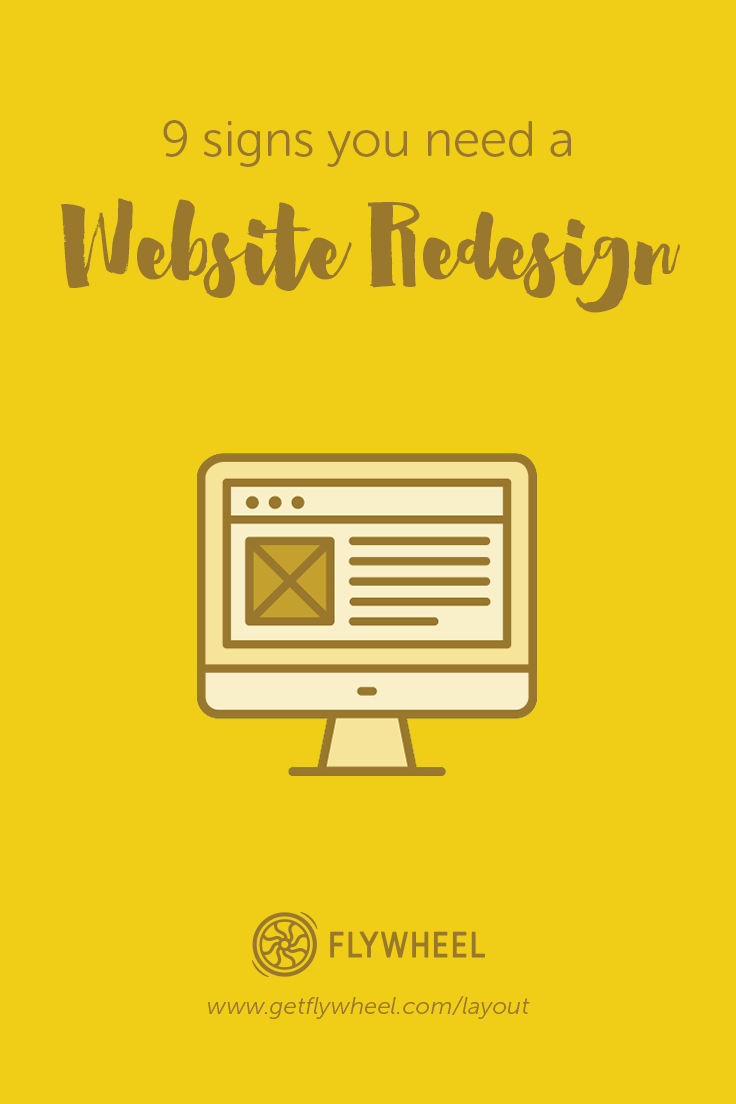
If your website were on a seven-second speed date, how appealing would it be?
Seven seconds may not sound long to make a decision, but as human beings we’re used to making snap judgments based on appearance. And when it comes to the online world, most people judge your website – and therefore your business – in seven seconds.
In that time you have to capture your visitors’ attention, show them around, give them a splash of your personality, and ensure you represent yourself in the best possible light.
No pressure.
Redesigning your website can seem overwhelming and it can take a significant amount of time and money, but it could also be a game-changer for your business.
If you’re unsure whether the time is right for a website overhaul, here are nine telltale signs your website is ready for a redesign.
1. It doesn’t accurately reflect your brand
Brands naturally evolve over the years, but if your website doesn’t reflect that, you’re doing your business a disservice. A change in your business offerings, a fresh new logo, or a rethinking of your brand color scheme are all good reasons to justify a redesign of your website.
You want to send the message that your business is healthy, looking to the future, and actively taking on new customers. To do that you need an attractive, understandable website that’s aligned with your core values and has a clear navigational flow.
Essentially, you want visitors to feel like they’re engaging with an actual person from your organization.
2. It’s difficult to navigate
User experience is a critical part of any website, so when a potential customer lands on your site, it should be clear from the outset what your business offers and how it can help them with their problem.
Put yourself in your customers’ shoes and see how long it takes to find what they’re looking for. If you can’t do it within one or two clicks, chances are they’ll get bored and scoot off somewhere else. Perusing a website shouldn’t feel like hard work. Your navigation needs to be accessible from every page, any buttons should be large enough to tap on the smallest of screens, and check carefully that none of your internal links lead to 404 errors.
You’re aiming for improved navigation, clearer calls to action, better internal links, and an overall reduction of clutter and distractions.
3. It isn’t responsive
Is your website responsive? Does it work equally well on all screen sizes from the smallest smartphone to the largest desktop? If the answer is no, then you’re potentially losing business every time somebody finds you on an incompatible screen. Which in today’s world will be often!
Users are increasingly accessing the web via tablets and smartphones, so your website has to cater for that.
4. Your audience has evolved
As your business evolves, so will your audience. And if you’re targeting a different clientele today than you were a few years back, chances are your website will be appealing to the wrong demographic.
If you haven’t set up new buyer personas, now is the time. Consider the different needs of your target audience and restructure your navigational pathways accordingly. Freshen up your copy and content to meet their needs, and consider which colors would best appeal to them.
Whatever you do, always ensure the needs of your primary audience are met first.
5. You’re lagging behind your main competitors
Keeping up with the Joneses is a bit of a cliché and I don’t recommend obsessing over what your competitors are doing, but do keep an eye on them. If your rivals have a shiny new website with great design and easy navigation, chances are your audience may prefer to do business over there.
Bear in mind your industry will affect how frequently you should update your website. Consumer sites need to incorporate recent design trends to stay fresh, but if your website is information-based or in the technical or manufacturing fields, your need isn’t quite as pressing.
Take care you don’t copy your rivals’ new ideas though. By all means take influence from design trends that work well in your industry, but adapt them so your offering is better, not a mere copycat.
6. It’s slow to load
Slow-loading sites are incredibly frustrating to use and often result in visitors quickly hitting the back button in search of something a little more responsive. In general, if your site takes longer than five seconds to load, it needs some attention. There could be several reasons for this; files might not have been compressed properly or updates might’ve been missed on the back end.
Not all of these reasons require a complete web redesign, but in an age when the majority of people browse the web on the go – and therefore chew up a lot of data – ensuring the site is optimized for them is essential. The current trend is to make sites faster to load and to only download large files – such as photos and videos – as you scroll down.
7. You need to add new functionality
As your business evolves, you may need to add new functionality to your website, such as eCommerce or a custom quoting engine. But adding a bolt-on tool isn’t always effective and it can cost more than a new design with the feature already built in. So a website redesign may be the best option.
It isn’t just functionality either. In 2017, your marketing arsenal should incorporate a lot of digital tools – search engine optimization, social media, content marketing, compelling visuals, and different media – but does your current website have the ability to help flex your marketing muscle?
You need tools for keyword optimization and an SEO-friendly URL structure, landing templates for ad campaigns, social media buttons, templates for a blog and news items, and product and sales pages that are focused on making those crucial conversions. If your website can’t help with this, you need to find one that can.
8. Your web traffic is static or declining
If your web traffic has reached an impasse or begun to decline, that’s a sign something isn’t quite going to plan. This doesn’t necessarily mean you need a complete redesign; a revamp of your content might be enough to freshen it up.
However, if the site itself is stale, looks old and outdated when people land on it, and is clunky to use, you might want to consider a complete overhaul.
9. It’s more than five years old
As I mentioned in point 5, the frequency with which you update your website will depend a little on the industry you’re in. However, using modern web design to tell your brand story and market your business offerings is more likely to engage your audience and leave a strong impression on them, encouraging repeat visits – and repeat business.
Technology and marketing moves so rapidly that what looked good and worked well five years ago is unlikely to have the same effect today. So if your website is five years or older, now is a great time to consider updating it.
Your website is much more than a mere tool; it’s a credibility builder for your business. If it’s outdated and difficult to use, what does that say about your business?
All too often, your website is the first point of contact for potential customers, so leaving a good first impression is crucial. If it’s difficult to navigate, no longer reflects your brand or appeals to your target audience, is slow to load, or isn’t responsive, it could be time to think about a redesign.
How can you tell if it’s time to redesign a website? What has you reaching for the back button? Can you add anything to our list? Tell us below.












Comments ( 1 )
Nikola
February 23, 2017
All points in place, but main thing you did not mention is budget. For most clients budget is always #1.
Mitch Britt
June 11, 2017
I think budget is important, but I have found many small businesses do not understand the full value of an effective Website. You have to explain the value and ROI behind an effective Website. We have to educate Clients and show why the project costs what it does. Many businesses do not budget enough for a website, and it is our job to guide them.